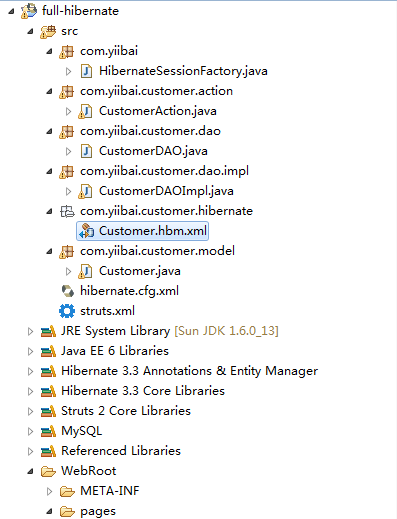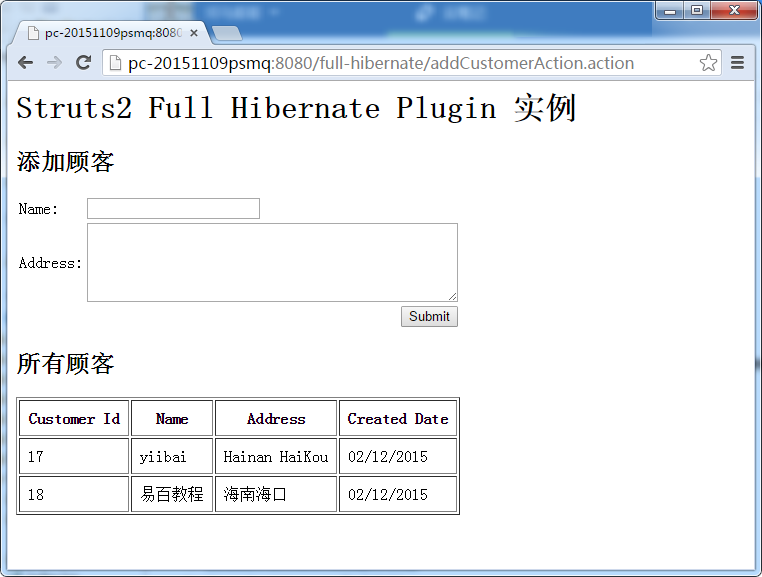在上篇 Struts2 + Hibernate集成 實例中, 它使用 servlet 上下文監聽 Hibernate 的 Session,而且把Struts2和Hibernate框架集成。
但是,總有一些東西要提高。在本教程中,我們將展示如何整合Struts2+Hibernate,並使用Struts2一個名為“Full Hibernate Plugin“的插件。
見下麵的集成步驟:
- 把 “Full Hibernate Plugin” jar 放入到工程類路徑。
- 使用 “@SessionTarget” 注釋來注入到 Hibernate session; 當“@TransactionTarget” 注釋注入到Hibernate 事務。
- 在 struts.xml, 讓包擴展 “hibernate-default“,而不是默認的堆疊。
看看下麵的關係:
Struts 2 <-- (Full Hibernate Plugin) ---> Hibernate <-----> Database
注,
本教程是從以前的 Struts2 + Hibernate集成 實例(servlet context listener)更新版本。因此,JSP 和 Hibernate 配置基本相同,只是整合的部分是有點不同,嘗試比較既能發現不同。
本教程是從以前的 Struts2 + Hibernate集成 實例(servlet context listener)更新版本。因此,JSP 和 Hibernate 配置基本相同,只是整合的部分是有點不同,嘗試比較既能發現不同。
1. 工程結構
在節教學,我們創建一個工程名為 full-hibernate 的web工程。看看這個專案檔夾的完整結構。


2. MySQL創建表腳本
Customer表結構
CREATE TABLE `customer` ( `customer_id` bigint(20) unsigned NOT NULL AUTO_INCREMENT, `name` varchar(45) NOT NULL, `address` varchar(255) NOT NULL, `create_date` datetime NOT NULL, PRIMARY KEY (`customer_id`) ) ENGINE=InnoDB AUTO_INCREMENT=2 DEFAULT CHARSET=utf8;
3. Hibernate相關配置
所有 Hibernate 的模型和配置的東西。
Customer.java – 為customer 表創建一個類。
package com.zaixian.customer.model;
import java.util.Date;
public class Customer implements java.io.Serializable {
private Long customerId;
private String name;
private String address;
private Date createdDate;
//getter and setter methods
}
Customer.hbm.xml – Hibernate 的 customer 表映射。
<?xml version="1.0"?>
<!DOCTYPE hibernate-mapping PUBLIC "-//Hibernate/Hibernate Mapping DTD 3.0//EN"
"http://hibernate.sourceforge.net/hibernate-mapping-3.0.dtd">
<!-- Generated 20 Julai 2010 11:40:18 AM by Hibernate Tools 3.2.5.Beta -->
<hibernate-mapping>
<class name="com.zaixian.customer.model.Customer"
table="customer" catalog="zaixian">
<id name="customerId" type="java.lang.Long">
<column name="CUSTOMER_ID" />
<generator class="identity" />
</id>
<property name="name" type="string">
<column name="NAME" length="45" not-null="true" />
</property>
<property name="address" type="string">
<column name="ADDRESS" not-null="true" />
</property>
<property name="createdDate" type="timestamp">
<column name="CREATED_DATE" length="19" not-null="true" />
</property>
</class>
</hibernate-mapping>
檔: hibernate.cfg.xml, Hibernate 資料庫配置
<?xml version="1.0" encoding="utf-8"?>
<!DOCTYPE hibernate-configuration PUBLIC
"-//Hibernate/Hibernate Configuration DTD 3.0//EN"
"http://hibernate.sourceforge.net/hibernate-configuration-3.0.dtd">
<hibernate-configuration>
<session-factory>
<property name="hibernate.bytecode.use_reflection_optimizer">false</property>
<property name="hibernate.connection.password">password</property>
<property name="hibernate.connection.url">jdbc:mysql://localhost:3306/zaixian</property>
<property name="hibernate.connection.username">root</property>
<property name="hibernate.dialect">org.hibernate.dialect.MySQLDialect</property>
<property name="show_sql">true</property>
<property name="format_sql">true</property>
<property name="use_sql_comments">false</property>
<mapping resource="com/zaixian/customer/hibernate/Customer.hbm.xml" />
</session-factory>
</hibernate-configuration>
5. DAO
實現DAO設計模式執行數據庫操作。在 CustomerDAOImpl 類, 聲明Hibernate會話和事務為類成員。在Struts 2的專案初始化, “Full Hibernate Plugin” 使用 @SessionTarget 和 @TransactionTarget 分別標注將注入相應的 Hibernate 會話和事務成為類成員。
CustomerDAO.java
package com.zaixian.customer.dao;
import java.util.List;
import com.zaixian.customer.model.Customer;
public interface CustomerDAO{
void addCustomer(Customer customer);
List<Customer> listCustomer();
}
CustomerDAOImpl.java
package com.zaixian.customer.dao.impl;
import java.util.List;
import org.hibernate.Session;
import org.hibernate.Transaction;
import com.googlecode.s2hibernate.struts2.plugin.annotations.SessionTarget;
import com.googlecode.s2hibernate.struts2.plugin.annotations.TransactionTarget;
import com.zaixian.customer.dao.CustomerDAO;
import com.zaixian.customer.model.Customer;
public class CustomerDAOImpl implements CustomerDAO{
@SessionTarget
Session session;
@TransactionTarget
Transaction transaction;
//add the customer
public void addCustomer(Customer customer){
session.save(customer);
}
//return all the customers in list
public List<Customer> listCustomer(){
return session.createQuery("from Customer").list();
}
}
6. Action
在Action類,調用DAO類來執行數據庫操作。
CustomerAction.java
package com.zaixian.customer.action;
import java.util.ArrayList;
import java.util.Date;
import java.util.List;
import com.zaixian.customer.dao.CustomerDAO;
import com.zaixian.customer.dao.impl.CustomerDAOImpl;
import com.zaixian.customer.model.Customer;
import com.opensymphony.xwork2.ActionSupport;
import com.opensymphony.xwork2.ModelDriven;
public class CustomerAction extends ActionSupport
implements ModelDriven{
Customer customer = new Customer();
List<Customer> customerList = new ArrayList<Customer>();
CustomerDAO customerDAO = new CustomerDAOImpl();
public String execute() throws Exception {
return SUCCESS;
}
public Object getModel() {
return customer;
}
public List<Customer> getCustomerList() {
return customerList;
}
public void setCustomerList(List<Customer> customerList) {
this.customerList = customerList;
}
//save customer
public String addCustomer() throws Exception{
//save it
customer.setCreatedDate(new Date());
customerDAO.addCustomer(customer);
//reload the customer list
customerList = null;
customerList = customerDAO.listCustomer();
return SUCCESS;
}
//list all customers
public String listCustomer() throws Exception{
customerList = customerDAO.listCustomer();
return SUCCESS;
}
}
7. JSP 頁面
JSP頁面添加並列出客戶。
customer.jsp
<%@ taglib prefix="s" uri="/struts-tags" %> <%@ taglib prefix="s" uri="/struts-tags" %> <html> <head> </head> <body> <h1>Struts 2 Full Hibernate Plugin example</h1> <h2>Add Customer</h2> <s:form action="addCustomerAction" > <s:textfield name="name" label="Name" value="" /> <s:textarea name="address" label="Address" value="" cols="50" rows="5" /> <s:submit /> </s:form> <h2>All Customers</h2> <s:if test="customerList.size() > 0"> <table border="1px" cellpadding="8px"> <tr> <th>Customer Id</th> <th>Name</th> <th>Address</th> <th>Created Date</th> </tr> <s:iterator value="customerList" status="userStatus"> <tr> <td><s:property value="customerId" /></td> <td><s:property value="name" /></td> <td><s:property value="address" /></td> <td><s:date name="createdDate" format="dd/MM/yyyy" /></td> </tr> </s:iterator> </table> </s:if> <br/> <br/> </body> </html>
8. struts.xml
鏈接所有〜讓包擴展 “hibernate-default” 來代替 “struts-default“.
<?xml version="1.0" encoding="UTF-8" ?>
<!DOCTYPE struts PUBLIC
"-//Apache Software Foundation//DTD Struts Configuration 2.0//EN"
"http://struts.apache.org/dtds/struts-2.0.dtd">
<struts>
<constant name="struts.devMode" value="true" />
<package name="default" namespace="/" extends="hibernate-default">
<action name="addCustomerAction"
class="com.zaixian.customer.action.CustomerAction" method="addCustomer" >
<result name="success">pages/customer.jsp</result>
</action>
<action name="listCustomerAction"
class="com.zaixian.customer.action.CustomerAction" method="listCustomer" >
<result name="success">pages/customer.jsp</result>
</action>
</package>
</struts>
9. 實例
訪問以下網址 : http://localhost:8080/full-hibernate/addCustomerAction.action


參考
下載代碼
下載所有源代碼 – http://pan.baidu.com/s/1o6tjSam
上一篇:
Struts2+Quartz2調度集成實例
下一篇:
Struts2+Hibernate集成實例
